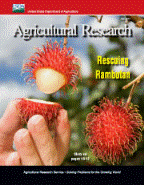United States Department of Agriculture: Agricultural Research Service, Lincoln, Nebraska

Agricultural Research Magazine
Date of this Version
4-2013
Document Type
Article
Citation
Agricultural Research (April 2013)
Abstract
Agricultural Research Service scientists in New York and California have developed very different technologies that share a common thread. They offer scientists new, innovative ways to probe what happens when a crop is threatened by drought or disease.
Michelle Cilia and Stewart Gray, ARS scientists at the Robert W. Holley Center for Agriculture and Health in Ithaca, New York, and their colleagues at the University of Washington have found a way to map the structure of an elusive protein that gives certain plant viruses the ability to travel from plants to insects, through the insects, and back into plants.
Andrew McElrone, a plant physiologist in the Crops Pathology and Genetics Research Unit in Davis, California, has adapted computed tomography (CT) scan technology to vastly improve on the tools available for studying how water and pathogens move through vascular plant tissue called “xylem.” The work has opened a window into how grapevines respond to drought stress and is shedding light on vascular networks in a number of other crops.
Luteovirus Proteins: It’s the Shape That Counts
To move from plant to plant, luteoviruses, such as potato leafroll virus and soybean dwarf virus, need to stay in the infected plant’s phloem tissues, which carry sugars and other substances in the plant, so they can be ingested by a feeding aphid. Once inside the aphid, the virus must pass through the insect’s gut and salivary tissues before it can be passed into another plant by the aphid. To accomplish that remarkable journey, viruses need to PEGGY GREB (D2825-1) MICHELLE CILIA, JAMES BRUCE (D2833-1) assemble proteins into larger packages known as “virions.”
Each luteovirus species is very particular and can only be transmitted by a few species of aphids. Cilia, Gray, and their partners James Bruce and Juan Chavez of the University of Washington think that the outside shape, or topology, of the virion plays a major role in that specificity, determining whether a virus will be able to move through the aphid and infect a plant.
Included in
Agriculture Commons, Animal Sciences Commons, Food Science Commons, Plant Sciences Commons

